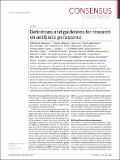Definitions and guidelines for research on antibiotic persistence
Author(s)
Balaban, Nathalie Q.; Helaine, Sophie; Lewis, Kim; Ackermann, Martin; Aldridge, Bree; Andersson, Dan I.; Brynildsen, Mark P.; Bumann, Dirk; Camilli, Andrew; Collins, James J.; Dehio, Christoph; Fortune, Sarah; Ghigo, Jean-Marc; Hardt, Wolf-Dietrich; Harms, Alexander; Heinemann, Matthias; Hung, Deborah T.; Jenal, Urs; Levin, Bruce R.; Michiels, Jan; Storz, Gisela; Tan, Man-Wah; Tenson, Tanel; Van Melderen, Laurence; Zinkernagel, Annelies; ... Show more Show less
DownloadPublished version (927.6Kb)
Publisher with Creative Commons License
Publisher with Creative Commons License
Creative Commons Attribution
Terms of use
Metadata
Show full item recordAbstract
Increasing concerns about the rising rates of antibiotic therapy failure and advances in single-cell analyses have inspired a surge of research into antibiotic persistence. Bacterial persister cells represent a subpopulation of cells that can survive intensive antibiotic treatment without being resistant. Several approaches have emerged to define and measure persistence, and it is now time to agree on the basic definition of persistence and its relation to the other mechanisms by which bacteria survive exposure to bactericidal antibiotic treatments, such as antibiotic resistance, heteroresistance or tolerance. In this Consensus Statement, we provide definitions of persistence phenomena, distinguish between triggered and spontaneous persistence and provide a guide to measuring persistence. Antibiotic persistence is not only an interesting example of non-genetic single-cell heterogeneity, it may also have a role in the failure of antibiotic treatments. Therefore, it is our hope that the guidelines outlined in this article will pave the way for better characterization of antibiotic persistence and for understanding its relevance to clinical outcomes.
Date issued
2019-04Department
Massachusetts Institute of Technology. Institute for Medical Engineering & Science; Massachusetts Institute of Technology. Department of Biological Engineering; Massachusetts Institute of Technology. Synthetic Biology CenterJournal
Nature Reviews Microbiology
Publisher
Springer Science and Business Media LLC
Citation
Balaban, Nathalie Q. et al. "Definitions and guidelines for research on antibiotic persistence." Nature Review Microbiology 17, 7 (July 2019): 441–448 © 2019 Springer Nature Limited
Version: Final published version
ISSN
1740-1526
1740-1534
Keywords
General Immunology and Microbiology